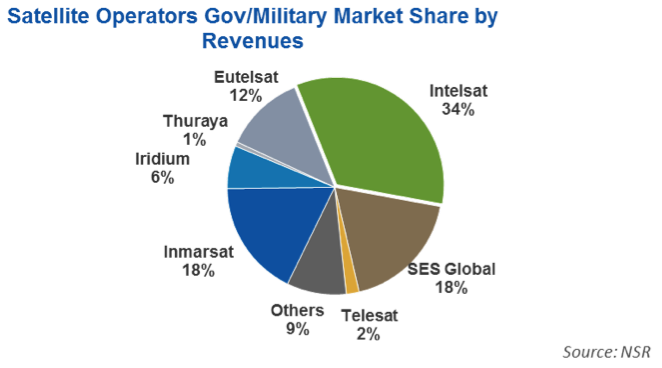Government & Military Satcom: A Work in Progress?
Jan 15th, 2014
by Claude Rousseau, NSR
With the raft of bad news from recent earning calls stating
lower government revenues in the satellite industry, one has to
ask the question: is a pessimistic view of the market fair when
the changes coming will grow the market pie and offer more
bits-per-hertz at a cheaper unit price.
The truth is that pessimistic views overshadow many
opportunities for solutions developed over the past ten years
that address military requirements of lower budgets while at the
same time offering more bandwidth.
The inventor of electricity Thomas Edison once said:
‘Opportunity is missed by most people because it is dressed in
overalls and looks like work’. Well, these new opportunities
for the government and military users are indeed a lot of work
with many still a work-in-progress. But these will not
only change the make-up of the off-the-shelf products available
but also who will jostle for position at the top of this
marketplace.
On top of everyone’s agenda is meeting budget cuts, while at
the same time addressing ballooning requirements for end-users,
and to top it off, on-the-move. With huge steps in
capacity coming online via high-throughput satellites (HTS),
there is some elbowing going on within the industry to meet the
mandate of governments to ‘do more with less’, in particular for
high-potential mobility applications.
As the graph below shows, when assessing satellite operators
serving this market, the largest portion of the pie is captured
by FSS operators who generated more than 75% of revenues, while
MSS operators take the rest. Intelsat, which expanded its
off-network portfolio (MSS, X-band), has staved off competition
and is far ahead in first, taking in approx. one-third of total
market revenues.
Interesting to note, however, is the two companies that are
just behind in 2nd place. SES, with a video-centric
core and Inmarsat, with a merchant marine base of users, will
likely not only rub shoulders more often in this market but
participate in steering changes to meet the new high-bandwidth,
low-cost challenges of government users. Furthermore,
their market position will likely be determined by how well they
can add more value to users with broadband mobility
requirements.

When looking at this chart, one would say that today Inmarsat
is a strong contender, but it has a lot of room to grow its
government business. In particular, its FSS offering has been
met with far less success than it would have hope for. The
pull-out of troops in the Middle-East, the U.S Navy
decommissioning of its terminals on a couple of hundred ships
and the U.S. Coast Guard’s choice of Ku-Band VSATs for its
Cutter Class vessels’ primary means of communications, instead
of Fleet Broadband, are all misfortunes that the operators has
had to grapple with over the past five years.
For SES, their position as a more diversified operator
worldwide and its investment in the high-throughput market via
O3b Networks has lessened the hit. Several new Ku-band
transponders over oceans are also taking them on the path to
address the market for bandwidth and mobile solutions.
And for Intelsat, keeping its no.1 share also means it must
capitalize on its HTS EPIC satellites and deploy more capacity
over places where ships, airborne platforms and UAVs fly, to
lessen the recent drop in revenues due to transponder price cuts
offered to the U.S. Government.
Having said this, it is easier to see why Inmarsat, which
will be the first out of the gate with a global fleet of
satellites offering high-throughput capacity to government
users, is still targeting this market. A good portion of its
revenue is expected to come from the agreement in place with
Boeing whereby the satellite manufacturer’s take-or-pay of 10%
of the fleet’s capacity aims at getting military users onto the
military Ka-band part of Global Xpress payload. Specifically,
these services will have advantages for troops, ships and
airborne platforms with an ‘almost-like’ WGS connectivity on a
global basis that is becoming a strategic communications
infrastructure for many countries around the globe. And thus,
with this key advantage, Inmarsat is hoping to forge itself a
future expansion in the government FSS business in a market in
dire need of cheaper bits.
Bottom Line
The increased efforts to reduce the cost
of communications links by satellite operators will not only
bring more benefits to government and military users, but also
create a more dynamic market where both FSS and MSS services
will increasingly collide into each other. The work-in-progress
sign is still up on the doors of many satellites operators
targeting the higher bandwidth and mobility government satcom
markets, but the opportunities are likely to be just beyond the
doorway.